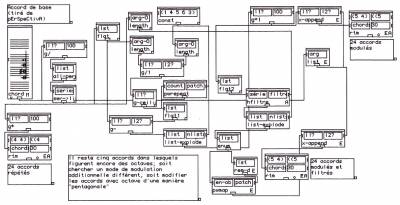Ceci est une ancienne révision du document !
Computer-Aided Composition
Since it was founded in 1992 the Music Representations team attempted to build a coherent research thread clearly identified under the name of Computer Assisted Composition (CAC – now also called Computer-Aided Composition), with a particular accent on the concept of "écriture" (an untranslatable French term which is the union of instrumental score writing and musical thought in general — we will use here the term "writing").
[Extracts from Computer Assited Composition Today, G. Assayag, 1998:]
"Instrumental writing seems to us a field of study which is at the same time precise and open: it constitutes a still unequalled model of adequacy between combinatorial systems of operations on sets of symbols on one hand and a sound universe having its own rules of perceptive and cognitive operation on the other hand. Indeed, the notation operates a coherent link between these two worlds. By there, it is also open to integration of new sound materials – extensions of the instrumental world, synthesis and transformation of sound. Instrumental writing brings with itself an almost ideal combination of formalization, codification, notation, and relation to the physical and perceptive world. We will thus employ the term Computer Assisted Composition while privileging, among all possible interpretations, the one that approaches at most the idea of instrumental writing. CAC systems will have to be able to bring an effective help in the specific case of instrumental writing; they will have to constitute a coherent link between the latter and new (synthetic) sound fields. They will be able in the long term to constitute good models for the control of pure synthesis."
[…]
"Because of the very great diversity of esthetical and formal (or anti-formal) models which coexists in contemporary music, one cannot imagine any more a CAC environment as a rigid application offering a finished collection of procedures for generation and transformation. On the contrary, we conceive such an environment as a specialized computer language that composers will use to build their own musical universe. Of course, the idea is not to provide them with a traditional language, whose control requires a great technical expertise, but a language arranged especially for their needs. This leads us to reflect on the various existing programming models, as well as on the interfaces, preferably graphical, intuitive, which make it possible to control this programming, and on the representations, internal and external, of the musical structures, which will be built and transformed using this programming. The ideal is thus a language that encapsulates in a consubstantial way the concept of notation, notation of the result (a musical score) but also notation of the process leading to this result (a visual program)."
Several experimental environments for music production were carried out according to these principles, in particular, PatchWork (by M. Laurson, J. Duthen, C. Rueda, C. Agon and G. Assayag) and OpenMusic (C. Agon, G. Assayag, J. Bresson).
Visual programmes and musical editors in PatchWork
Links to related (sub)projects
- OpenMusic: Visual programming environment for Computer-Aided Composition
- The RQ library: Rhythm Quantification for OpenMusic
- EFFICAC(e): Extended Frameworks for "In-time" Computer-Aided Composition.
